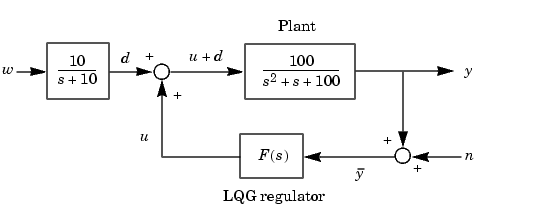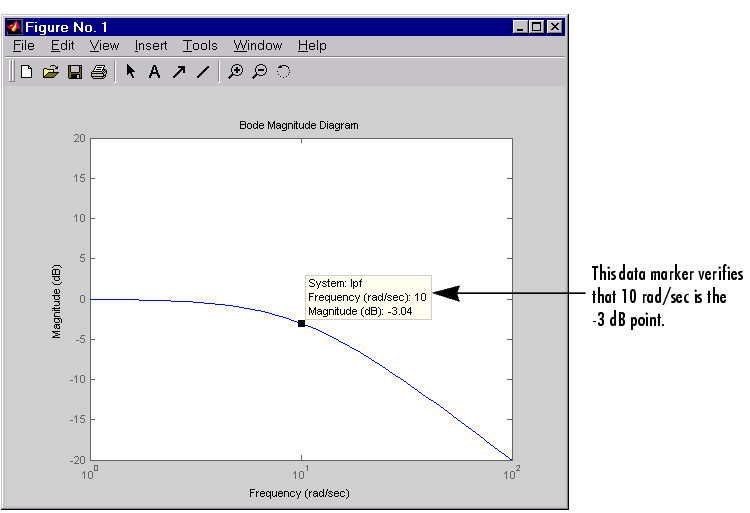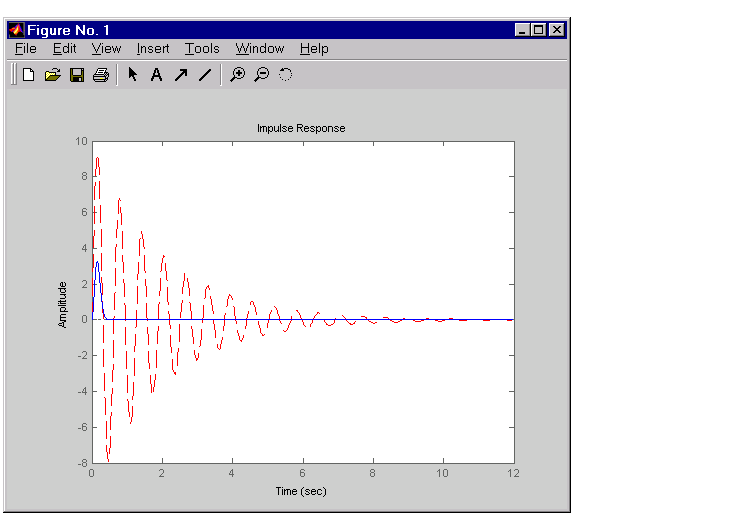

| Getting Started |   |
Example: LQG Design
As an example of LQG design, consider the regulation problem illustrated below.

Figure 4-51: Simple Regulation Loop
The goal is to regulate the plant output  around zero. The input disturbance
around zero. The input disturbance  is low frequency with power spectral density (PSD) concentrated below 10 rad/sec. For LQG design purposes, it is modeled as white noise driving a low-pass filter with a cutoff at 10 rad/sec, as this figure shows.
is low frequency with power spectral density (PSD) concentrated below 10 rad/sec. For LQG design purposes, it is modeled as white noise driving a low-pass filter with a cutoff at 10 rad/sec, as this figure shows.

This figure shows the Bode magnitude of the shaping filter.

Figure 4-52: Bode Magnitude of the Low-Pass Filter
There is some measurement noise  , with noise intensity given by
, with noise intensity given by

to specify the trade-off between regulation performance and cost of control. Note that an open-loop state-space model is

where  is a state-space realization of
is a state-space realization of  .
.
The following commands design the optimal LQG regulator  for this problem.
for this problem.
sys = ss(tf(100,[1 1 100])) % State-space plant model % Design LQ-optimal gain K K = lqry(sys,10,1) % u = -Kx minimizes J(u) % Separate control input u and disturbance input d P = sys(:,[1 1]); % input [u;d], output y % Design Kalman state estimator Kest. Kest = kalman(P,1,0.01) % Form LQG regulator = LQ gain + Kalman filter. F = lqgreg(Kest,K)
The last command returns a state-space model F of the LQG regulator  . Note that
. Note that lqry, kalman, and lqgreg perform discrete-time LQG design when applied to discrete plants.
To validate the design, close the loop with feedback, create and add the lowpass filter in series with the closed-loop system, and compare the open- and closed-loop impulse responses by using the impulse function.
% Close loop clsys = feedback(sys,F,+1) % Note positive feedback. % Create the lowpass filter and add it in series with clsys. s = tf('s'); lpf= 10/(s+10) ; clsys_fin = lpf*clsys; % Open- vs. closed-loop impulse responses impulse(sys,'r--',clsys_fin,'b-')
This figure compares the open- and closed-loop impulse responses for this example.

Figure 4-53: Comparison of Open- and Closed-Loop Impulse Response for the LQG Example
 | Linear-Quadratic-Gaussian (LQG) Design | Example: LQG Design for Set Point Tracking |  |